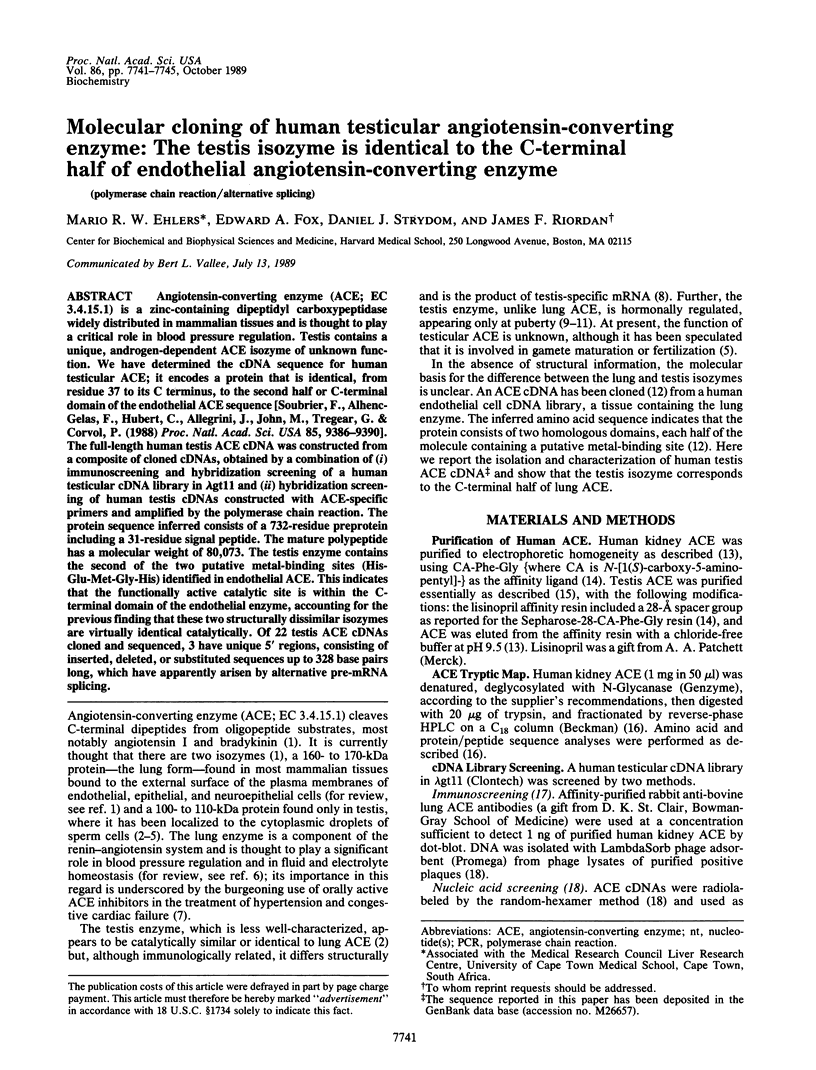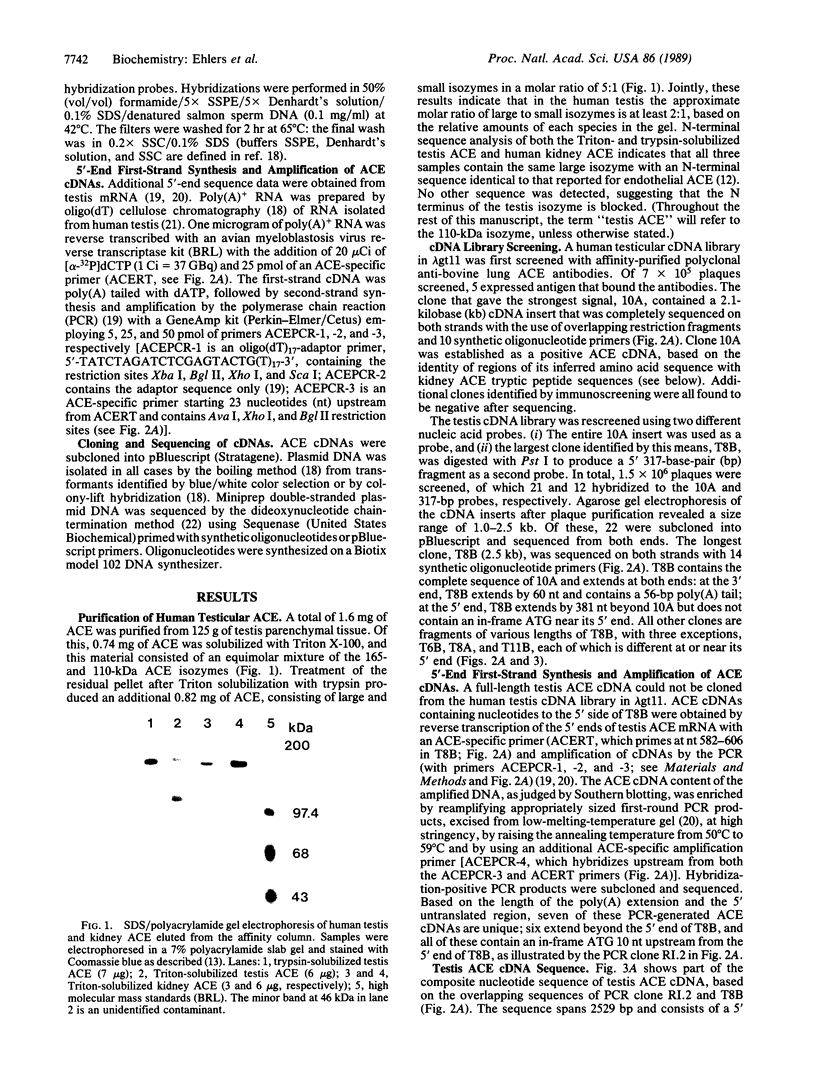Abstract
Angiotensin-converting enzyme (ACE; EC 3.4.15.1) is a zinc-containing dipeptidyl carboxypeptidase widely distributed in mammalian tissues and is thought to play a critical role in blood pressure regulation. Testis contains a unique, androgen-dependent ACE isozyme of unknown function. We have determined the cDNA sequence for human testicular ACE; it encodes a protein that is identical, from residue 37 to its C terminus, to the second half or C-terminal domain of the endothelial ACE sequence [Soubrier, F., Alhenc-Gelas, F., Hubert, C., Allegrini, J., John, M., Tregear, G. & Corvol, P. (1988) Proc. Natl. Acad. Sci. USA 85, 9386-9390]. The full-length human testis ACE cDNA was constructed from a composite of cloned cDNAs, obtained by a combination of (i) immunoscreening and hybridization screening of a human testicular cDNA library in lambda gt11 and (ii) hybridization screening of human testis cDNAs constructed with ACE-specific primers and amplified by the polymerase chain reaction. The protein sequence inferred consists of a 732-residue preprotein including a 31-residue signal peptide. The mature polypeptide has a molecular weight of 80,073. The testis enzyme contains the second of the two putative metal-binding sites (His-Glu-Met-Gly-His) identified in endothelial ACE. This indicates that the functionally active catalytic site is within the C-terminal domain of the endothelial enzyme, accounting for the previous finding that these two structurally dissimilar isozymes are virtually identical catalytically. Of 22 testis ACE cDNAs cloned and sequenced, 3 have unique 5' regions, consisting of inserted, deleted, or substituted sequences up to 328 base pairs long, which have apparently arisen by alternative pre-mRNA splicing.
Full text
PDF




Images in this article
Selected References
These references are in PubMed. This may not be the complete list of references from this article.
- Berg T., Sulner J., Lai C. Y., Soffer R. L. Immunohistochemical localization of two angiotensin I-converting isoenzymes in the reproductive tract of the male rabbit. J Histochem Cytochem. 1986 Jun;34(6):753–760. doi: 10.1177/34.6.3009604. [DOI] [PubMed] [Google Scholar]
- Brentjens J. R., Matsuo S., Andres G. A., Caldwell P. R., Zamboni L. Gametes contain angiotensin converting enzyme (kininase II). Experientia. 1986 Apr 15;42(4):399–402. doi: 10.1007/BF02118626. [DOI] [PubMed] [Google Scholar]
- Bünning P., Holmquist B., Riordan J. F. Functional residues at the active site of angiotensin converting enzyme. Biochem Biophys Res Commun. 1978 Aug 29;83(4):1442–1449. doi: 10.1016/0006-291x(78)91382-7. [DOI] [PubMed] [Google Scholar]
- Cushman D. W., Cheung H. S. Concentrations of angiotensin-converting enzyme in tissues of the rat. Biochim Biophys Acta. 1971 Oct;250(1):261–265. doi: 10.1016/0005-2744(71)90142-2. [DOI] [PubMed] [Google Scholar]
- Ehlers M. R., Maeder D. L., Kirsch R. E. Rapid affinity chromatographic purification of human lung and kidney angiotensin-converting enzyme with the novel N-carboxyalkyl dipeptide inhibitor N-[1(S)-carboxy-5-aminopentyl]glycylglycine. Biochim Biophys Acta. 1986 Sep 4;883(2):361–372. doi: 10.1016/0304-4165(86)90329-6. [DOI] [PubMed] [Google Scholar]
- Ehlers M. R., Riordan J. F. Angiotensin-converting enzyme: new concepts concerning its biological role. Biochemistry. 1989 Jun 27;28(13):5311–5318. doi: 10.1021/bi00439a001. [DOI] [PubMed] [Google Scholar]
- El-Dorry H. A., Bull H. G., Iwata K., Thornberry N. A., Cordes E. H., Soffer R. L. Molecular and catalytic properties of rabbit testicular dipeptidyl carboxypeptidase. J Biol Chem. 1982 Dec 10;257(23):14128–14133. [PubMed] [Google Scholar]
- El-Dorry H. A., MacGregor J. S., Soffer R. L. Dipeptidyl carboxypeptidase from seminal fluid resembles the pulmonary rather than the testicular isoenzyme. Biochem Biophys Res Commun. 1983 Sep 30;115(3):1096–1100. doi: 10.1016/s0006-291x(83)80048-5. [DOI] [PubMed] [Google Scholar]
- El-Dorry H. A., Pickett C. B., MacGregor J. S., Soffer R. L. Tissue-specific expression of mRNAs for dipeptidyl carboxypeptidase isoenzymes. Proc Natl Acad Sci U S A. 1982 Jul;79(14):4295–4297. doi: 10.1073/pnas.79.14.4295. [DOI] [PMC free article] [PubMed] [Google Scholar]
- Frohman M. A., Dush M. K., Martin G. R. Rapid production of full-length cDNAs from rare transcripts: amplification using a single gene-specific oligonucleotide primer. Proc Natl Acad Sci U S A. 1988 Dec;85(23):8998–9002. doi: 10.1073/pnas.85.23.8998. [DOI] [PMC free article] [PubMed] [Google Scholar]
- Hermo L., Dworkin J., Oko R. Role of epithelial clear cells of the rat epididymis in the disposal of the contents of cytoplasmic droplets detached from spermatozoa. Am J Anat. 1988 Oct;183(2):107–124. doi: 10.1002/aja.1001830202. [DOI] [PubMed] [Google Scholar]
- Johnston C. I. Angiotensin converting-enzyme inhibitors--the balance sheet. Med J Aust. 1988 May 16;148(10):488–489. doi: 10.5694/j.1326-5377.1988.tb99453.x. [DOI] [PubMed] [Google Scholar]
- Kozak M. Compilation and analysis of sequences upstream from the translational start site in eukaryotic mRNAs. Nucleic Acids Res. 1984 Jan 25;12(2):857–872. doi: 10.1093/nar/12.2.857. [DOI] [PMC free article] [PubMed] [Google Scholar]
- Lanzillo J. J., Stevens J., Dasarathy Y., Yotsumoto H., Fanburg B. L. Angiotensin-converting enzyme from human tissues. Physicochemical, catalytic, and immunological properties. J Biol Chem. 1985 Dec 5;260(28):14938–14944. [PubMed] [Google Scholar]
- Loh E. Y., Elliott J. F., Cwirla S., Lanier L. L., Davis M. M. Polymerase chain reaction with single-sided specificity: analysis of T cell receptor delta chain. Science. 1989 Jan 13;243(4888):217–220. doi: 10.1126/science.2463672. [DOI] [PubMed] [Google Scholar]
- Pandey K. N., Misono K. S., Inagami T. Evidence for intracellular formation of angiotensins: coexistence of renin and angiotensin-converting enzyme in Leydig cells of rat testis. Biochem Biophys Res Commun. 1984 Aug 16;122(3):1337–1343. doi: 10.1016/0006-291x(84)91238-5. [DOI] [PubMed] [Google Scholar]
- Pantoliano M. W., Holmquist B., Riordan J. F. Affinity chromatographic purification of angiotensin converting enzyme. Biochemistry. 1984 Feb 28;23(5):1037–1042. doi: 10.1021/bi00300a036. [DOI] [PubMed] [Google Scholar]
- Sanger F., Nicklen S., Coulson A. R. DNA sequencing with chain-terminating inhibitors. Proc Natl Acad Sci U S A. 1977 Dec;74(12):5463–5467. doi: 10.1073/pnas.74.12.5463. [DOI] [PMC free article] [PubMed] [Google Scholar]
- Shapiro R., Riordan J. F. Critical lysine residue at the chloride binding site of angiotensin converting enzyme. Biochemistry. 1983 Nov 8;22(23):5315–5321. doi: 10.1021/bi00292a010. [DOI] [PubMed] [Google Scholar]
- Soffer R. L., Berg T., Sulner J., Lai C. Y. Pulmonary and testicular angiotensin-converting isoenzymes. Clin Exp Hypertens A. 1987;9(2-3):229–234. doi: 10.3109/10641968709164182. [DOI] [PubMed] [Google Scholar]
- Soubrier F., Alhenc-Gelas F., Hubert C., Allegrini J., John M., Tregear G., Corvol P. Two putative active centers in human angiotensin I-converting enzyme revealed by molecular cloning. Proc Natl Acad Sci U S A. 1988 Dec;85(24):9386–9390. doi: 10.1073/pnas.85.24.9386. [DOI] [PMC free article] [PubMed] [Google Scholar]
- Strittmatter S. M., Snyder S. H. Angiotensin-converting enzyme in the male rat reproductive system: autoradiographic visualization with [3H]captopril. Endocrinology. 1984 Dec;115(6):2332–2341. doi: 10.1210/endo-115-6-2332. [DOI] [PubMed] [Google Scholar]
- Strittmatter S. M., Thiele E. A., De Souza E. B., Snyder S. H. Angiotensin-converting enzyme in the testis and epididymis: differential development and pituitary regulation of isozymes. Endocrinology. 1985 Oct;117(4):1374–1379. doi: 10.1210/endo-117-4-1374. [DOI] [PubMed] [Google Scholar]
- Strydom D. J., Harper J. W., Lobb R. R. Amino acid sequence of bovine brain derived class 1 heparin-binding growth factor. Biochemistry. 1986 Mar 11;25(5):945–951. doi: 10.1021/bi00353a001. [DOI] [PubMed] [Google Scholar]
- Velletri P. A., Aquilano D. R., Bruckwick E., Tsai-Morris C. H., Dufau M. L., Lovenberg W. Endocrinological control and cellular localization of rat testicular angiotensin-converting enzyme (EC 3.4.15.1). Endocrinology. 1985 Jun;116(6):2516–2522. doi: 10.1210/endo-116-6-2516. [DOI] [PubMed] [Google Scholar]
- Weare J. A., Gafford J. T., Lu H. S., Erdös E. G. Purification of human kidney angiotensin I converting enzyme using reverse-immunoadsorption chromatography. Anal Biochem. 1982 Jul 1;123(2):310–319. doi: 10.1016/0003-2697(82)90451-1. [DOI] [PubMed] [Google Scholar]
- Yotsumoto H., Sato S., Shibuya M. Localization of angiotensin converting enzyme (dipeptidyl carboxypeptidase) in swine sperm by immunofluorescence. Life Sci. 1984 Sep 17;35(12):1257–1261. doi: 10.1016/0024-3205(84)90096-1. [DOI] [PubMed] [Google Scholar]
- Young R. A., Davis R. W. Efficient isolation of genes by using antibody probes. Proc Natl Acad Sci U S A. 1983 Mar;80(5):1194–1198. doi: 10.1073/pnas.80.5.1194. [DOI] [PMC free article] [PubMed] [Google Scholar]
- von Heijne G. Patterns of amino acids near signal-sequence cleavage sites. Eur J Biochem. 1983 Jun 1;133(1):17–21. doi: 10.1111/j.1432-1033.1983.tb07424.x. [DOI] [PubMed] [Google Scholar]
- von Heijne G. Signal sequences. The limits of variation. J Mol Biol. 1985 Jul 5;184(1):99–105. doi: 10.1016/0022-2836(85)90046-4. [DOI] [PubMed] [Google Scholar]




